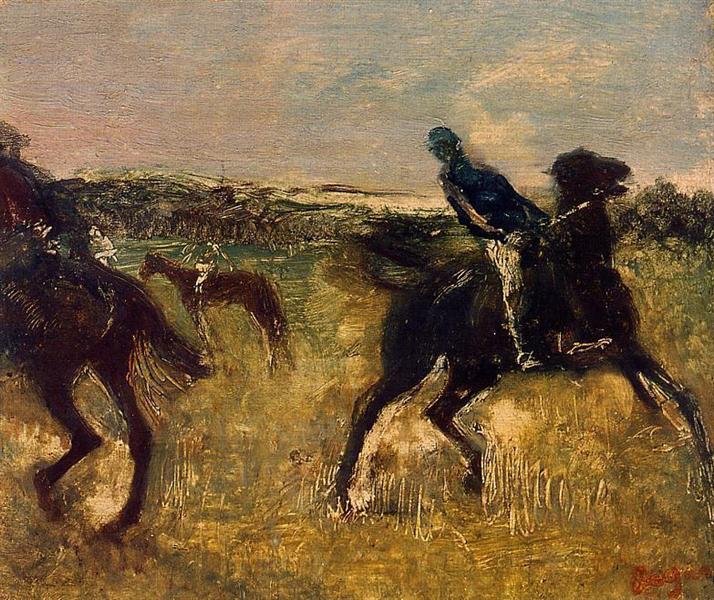Beskrivning
Edgar Degas's masterpiece, The Horsemen, from 1895, is part of a body of work in which movement and the representation of human movement become central themes. Degas, known for his fascination with modern life and its dynamic scenes, addresses in this piece the theme of horse riding, one of the themes that most attracted his attention throughout his artistic career. In The Horsemen, the artist captures the moment when the horsemen, in an energetic composition, seem to be lined up on the path of the competition, thus conveying a sense of imminent action.
The structure of the composition is remarkably asymmetrical, dominated by the placement of the horses and their riders who are grouped towards the left side of the work. This arrangement decision not only adds visual interest to the painting, but also feels like an invitation to contemplate the event to come. Degas, renowned for his ability to capture movement in his art, manages to make the horses appear almost in the act of galloping, with their arched necks and outstretched legs, elements that emphasize the potential detraction from inertia to action in the impending race.
Colour plays a central role in the visual narrative that Degas presents. Vibrant hues of blue, green and yellow combine to bring the scene to life, while subtle shadows add depth and a sense of volume that seems almost tangible. Degas also uses a palette that oscillates between darker tones and highlights, creating a contrast that highlights the musculature of the horses and the clothing of the riders. Every detail, from the rough suits of the jockeys to the majestic posture of the horses, seems to have been carefully considered, revealing the meticulousness with which Degas worked.
As for the characters in the work, although not entirely individualized, the riders function as stylized representations of the human figure in motion, that is, he does not seek to portray specific people, but rather riders as a community within a larger context. This approach is characteristic of Degas, who often portrayed figures in everyday situations, emphasizing their actions rather than their individuality. The use of perspective, particularly in the way Degas structures the height of the riders and horses in relation to the shot, shows a technical mastery that enhances the sense of realism and apprehension of the dynamics of the scene.
Degas's interest in life on the racetrack and the culture of show business in Paris reflects his spirit of the times, at a time when the hippodrome was becoming a major social and sporting centre. Through this work, Degas not only documented a social event, but also explored the boundaries between art and modern life, making him a precursor to the representation of movement that cinema anticipated.
“Riders” is ultimately a celebration of the vigor of movement and the spirit of competition, encapsulating Degas’ focus on capturing the fleeting essence of the human experience. When looking at this work, one can sense the passion of the moment, the tension of the race that is about to begin, and it is precisely this mastery of the depiction of movement that establishes Degas as a bridge between classical art and the innovations of modern art. Every stroke seems to invoke the urgency and vitality of the riders, while the viewer finds themselves on the shore of an experience that is both visual and visceral.
KUADROS ©, a famous painting on your wall.
Hand-made oil painting reproductions, with the quality of professional artists and the distinctive seal of KUADROS ©.
Painting reproduction service with satisfaction guarantee. If you are not completely satisfied with the replica of your painting, we will refund 100% of your money.

